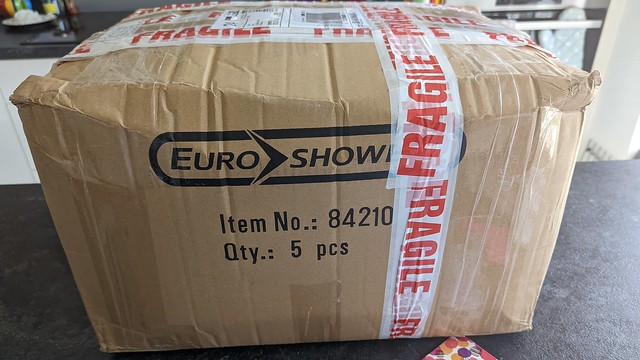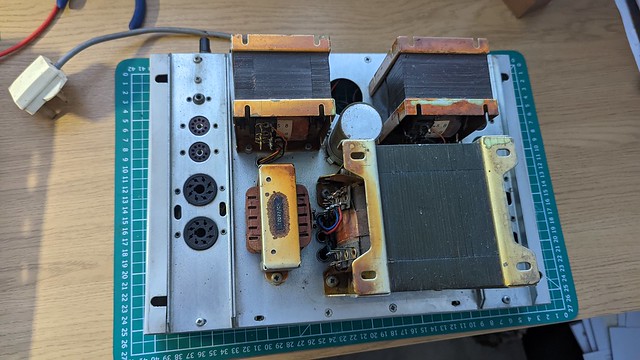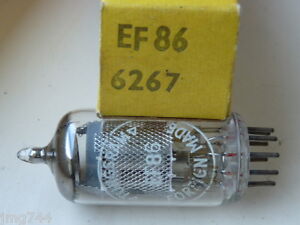chiily
PFM Special Builder
Today was the day that this package arrived...

Containing an STA15
 PXL_20220511_192628887 by Garf Arf, on Flickr
PXL_20220511_192628887 by Garf Arf, on Flickr
 PXL_20220511_192441396 by Garf Arf, on Flickr
PXL_20220511_192441396 by Garf Arf, on Flickr
Overall it doesn't look to be in too bad a shape.
 PXL_20220511_192355413 by Garf Arf, on Flickr
PXL_20220511_192355413 by Garf Arf, on Flickr
 PXL_20220511_192400164 by Garf Arf, on Flickr
PXL_20220511_192400164 by Garf Arf, on Flickr
 PXL_20220511_192427280 by Garf Arf, on Flickr
PXL_20220511_192427280 by Garf Arf, on Flickr
HT cap is not in the best, having had a little vent.
 PXL_20220511_162408127 1 by Garf Arf, on Flickr
PXL_20220511_162408127 1 by Garf Arf, on Flickr
Left and right boards looking untouched apart from the 470R resistors, which look to have been replaced at some time based on their pristine looks and the board being black from heat.
 PXL_20220511_162424785 1 by Garf Arf, on Flickr
PXL_20220511_162424785 1 by Garf Arf, on Flickr
...and the right board has more heat blackening, plus the resistors are a different type.
 PXL_20220511_162354140 1 by Garf Arf, on Flickr
PXL_20220511_162354140 1 by Garf Arf, on Flickr
Resting, in fact quite well stuck, on the RHD boards resistor is a chunk of glass, I assume from a valve, but who knows.
 PXL_20220511_162403530 1 by Garf Arf, on Flickr
PXL_20220511_162403530 1 by Garf Arf, on Flickr
Valve-wise it has four Blackburn Mullard EL34s in two pairs, one from 1966 and the other pair from 1969. Both 82s are Blackburn Mullards from 1965. One EF86 is a BRIMAR and the other I think a, well I'm not sure, here is a picture.
 PXL_20220511_160408294 1 by Garf Arf, on Flickr
PXL_20220511_160408294 1 by Garf Arf, on Flickr
The rectifier was a GZ32, very strange, again a Blackburn 1966 Mullard. I will do the diode mod to the amp in due course and add a modern, quality GZ34. I have a Harma Retro from Watford valves on the shelf.
I've checked the continuity of the transformers and all looks well. The seller did tell me that he had been using the amp up until a few days ago.
It does have a pair of chrome handles, sadly both are bent, one more than the other. Once I have then straightened out I'll take a couple of pics and post. The chrome on then is in good shape.
Be prepared for lots of questions...
First one, would it be heresy to drill out the rivets holding the phono connector and replace with 3M machine bolts? I would like to fit the same phono connectors I did to the Leak.
 PXL_20220410_143746981 by Garf Arf, on Flickr
PXL_20220410_143746981 by Garf Arf, on Flickr
 PXL_20220402_152219712 by Garf Arf, on Flickr
PXL_20220402_152219712 by Garf Arf, on Flickr

Containing an STA15
 PXL_20220511_192628887 by Garf Arf, on Flickr
PXL_20220511_192628887 by Garf Arf, on Flickr PXL_20220511_192441396 by Garf Arf, on Flickr
PXL_20220511_192441396 by Garf Arf, on FlickrOverall it doesn't look to be in too bad a shape.
 PXL_20220511_192355413 by Garf Arf, on Flickr
PXL_20220511_192355413 by Garf Arf, on Flickr PXL_20220511_192400164 by Garf Arf, on Flickr
PXL_20220511_192400164 by Garf Arf, on Flickr PXL_20220511_192427280 by Garf Arf, on Flickr
PXL_20220511_192427280 by Garf Arf, on FlickrHT cap is not in the best, having had a little vent.
 PXL_20220511_162408127 1 by Garf Arf, on Flickr
PXL_20220511_162408127 1 by Garf Arf, on FlickrLeft and right boards looking untouched apart from the 470R resistors, which look to have been replaced at some time based on their pristine looks and the board being black from heat.
 PXL_20220511_162424785 1 by Garf Arf, on Flickr
PXL_20220511_162424785 1 by Garf Arf, on Flickr...and the right board has more heat blackening, plus the resistors are a different type.
 PXL_20220511_162354140 1 by Garf Arf, on Flickr
PXL_20220511_162354140 1 by Garf Arf, on FlickrResting, in fact quite well stuck, on the RHD boards resistor is a chunk of glass, I assume from a valve, but who knows.
 PXL_20220511_162403530 1 by Garf Arf, on Flickr
PXL_20220511_162403530 1 by Garf Arf, on FlickrValve-wise it has four Blackburn Mullard EL34s in two pairs, one from 1966 and the other pair from 1969. Both 82s are Blackburn Mullards from 1965. One EF86 is a BRIMAR and the other I think a, well I'm not sure, here is a picture.
 PXL_20220511_160408294 1 by Garf Arf, on Flickr
PXL_20220511_160408294 1 by Garf Arf, on FlickrThe rectifier was a GZ32, very strange, again a Blackburn 1966 Mullard. I will do the diode mod to the amp in due course and add a modern, quality GZ34. I have a Harma Retro from Watford valves on the shelf.
I've checked the continuity of the transformers and all looks well. The seller did tell me that he had been using the amp up until a few days ago.
It does have a pair of chrome handles, sadly both are bent, one more than the other. Once I have then straightened out I'll take a couple of pics and post. The chrome on then is in good shape.
Be prepared for lots of questions...
First one, would it be heresy to drill out the rivets holding the phono connector and replace with 3M machine bolts? I would like to fit the same phono connectors I did to the Leak.
 PXL_20220410_143746981 by Garf Arf, on Flickr
PXL_20220410_143746981 by Garf Arf, on Flickr PXL_20220402_152219712 by Garf Arf, on Flickr
PXL_20220402_152219712 by Garf Arf, on Flickr




